All 5 entries tagged Roman Republic
No other Warwick Blogs use the tag Roman Republic on entries | View entries tagged Roman Republic at Technorati | There are no images tagged Roman Republic on this blog
January 01, 2020
A Bronze Neapolitan Coin and its Relevance to Rome
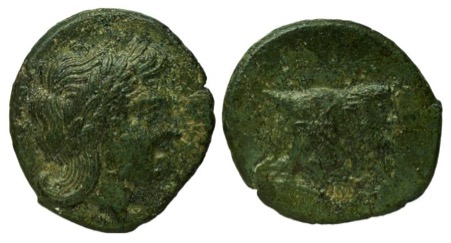
RRC 1/1, Bronze Coin minted in Neapolis (Naples), now in the Bibliothèque nationale de France, 3.03g, 17.7 mm
Obverse: Laureate head of Apollo
Reverse: A man-headed bull, with the legend ΡΩΜΑΙΩΝ (Romano).
This simple bronze coin is part of a collection of bronze and silver coinage discovered in the Naples area, dating to the late fourth century BC. It has often been described as one of the first true ‘Roman’ coins, and as such it is the first entry in Michael Crawford’s Roman Republican Coinage, the standard typology of Roman coins from this period. This is slightly misleading, given that Neapolis (modern day Naples) was not under direct Roman rule at this point and was a Greek speaking city, indeed, the legend on the coin itself is in Greek, despite making reference the Romans.
Neapolis was a fairly old city by this point, as there is evidence to suggest settlement in the Naples region as early as the first millennium BC, forming part of the great migration of Greeks from their heartlands in the east to southern Italy (Magna Graecia), Sicily and further afield in the western Mediterranean. Amongst other things, it is likely that it was the Greeks who first introduced true ‘coinage’ into Italy, in line with the discovery of coin hoards dating back to the sixth century in southern Italy. Therefore it is not surprising that the first example of coinage relating to Rome should have been discovered in a southern, Greek city. But why does the coin say ΡΩΜΑΙΩΝ ((coin) of the Romans)?
By the late fourth century BC, Rome was expanding its political reach down towards the southern end of the Italian peninsula. It was engaged in a series of wars with another Italic people, the Samnites of the south-central spine of Italy, and in this conflict many of the Greek cities of southern Italy were effectively forced to pick a side. The region of Campania, in which Neapolis was located, fell between the Romans and the Samnites and thus turned into a battleground between them. According to Livy, after a power struggle between the pro and anti-Roman factions within Neapolis, the city opened its doors to the Romans and signed a pact of alliance, the Foedus Aequissimum, with them. This is dated to around 326 BC, as the second Samnite war was getting under way, and this has also been taken as the earliest likely date for the coin being struck. It is thus possible that the use of ΡΩΜΑΙΩΝ on the coin was meant to publicise the Roman alliance to the general population, but that still does not explain the immediate reason for the coin being struck.
At this point it should be noted that the production of coinage in ancient states was generally not regularised to the same degree as in modern states. Whilst coins and notes are the predominant representation of physical wealth (and a key means of exchange) in the modern world, this was not the case in antiquity, where wealth might just as easily be represented by precious metals or even cattle; indeed it is interesting to note the similarity of the Latin term for money, pecunia, with the Indo-European root word for cattle, peku. Similarly, minted coinage was not necessarily needed for the purposes of exchange either. The Romans themselves appear to have gotten by without using minted coinage at all up until the third century BC, with small transactions seemingly conducted via the use of so called aes grave, literally rough bronze, nuggets of metal that were not shaped or minted in any fashion. Whilst in the modern world the intense quantity and velocity of financial transactions make it an imperative for central banks and mints to constantly replenish the physical money supply on a regularised basis in order to ensure liquidity, this was less the case in the ancient world where there were generally far fewer financial transactions and where the maintenance of ‘liquidity’ was not a concern of the issuers of money. Therefore, issues of ‘authorised’ coinage by cities tended to be made with a specific ‘goal’ in mind, such as to pay for public works or military campaigns, rather than to provide an easy means of conducting small scale private commerce.
The latter of these two examples provides a strong rationale for why this coin may have been minted. Given the new alliance with the Romans, Neapolis would have entered the war against the Samnites, which meant that the city would have had to pay to raise both troops and ships (for the treaty with Rome stipulated the provision of ships, naval warfare being a Roman weakness at this point) for the duration of the war. Coins represent an easy way of remunerating soldiers and sailors, as it relieves a state of the obligation to provide directly for them; if a soldier or sailor receives his dues in coins, he can use that new found wealth to pay for his own food, drink and other sundry expenses, as opposed to having that supplied by the state. Wars, in the ancient and modern eras, are often associated with large expansions of the money supply so as to pay for armies - the severe collapse of the value of Roman coinage during the ‘Crisis of the Third Century AD’ has been associated with large scale minting by various aspirants for the imperial throne in order to win and maintain the support of the soldiery. To return to Neapolis, minting this and other coins provided the city with a means to fund its obligation to the Roman alliance, which seems a sensible explanation for the profusion of Neapolitan coinage towards the end of the third century, a period of prolonged warfare in southern Italy.
This idea in turn provides an interesting link to the Roman ‘adoption’ of coinage in the third century. As Rome grew to be major power in the Italian peninsula and beyond, the amount of warfare that it engaged in inevitably increased; conflict with the Samnites in the fourth century would be followed by wars with Pyrrhus of Epirus and Carthage in the third century, wars that necessitated long military campaigns. Given that (even prior to the full professionalization of the military under Marius), the Roman state provided a stipendium to its troops, the amount paid out as part of this would likely have increased immeasurably during the long years of war in the third century, which perhaps explains why the Romans finally adopted coinage wholesale, as a utile means of providing the stipendium.
Returning to the coin itself, aside from the legend on it, the imagery is largely traditional and displays continuity with earlier Neapolitan coin issues. The bull-headed man on the reverse is a staple not just of Neapolitan coinage but of other coins of Magna Graecia, and has often been taken as a reference to the process of synoecism between Greek colonists and local Italic peoples, the bull being a traditionally Italic symbol (one later used on the coinage of Rome’s rebellious Italian allies during the Social War). On the obverse there is a depiction of the god Apollo, whom we are told by later poet Statius was among the patron gods of Neapolis, so again this is not a hugely surprising piece of imagery. It could thus be argued that the coin is representative of a fulcrum point in the history of Magna Graecia; Greek language and traditional Greek and Graeco-Italic symbolism remains on the coin, but the reference to the Romans is a clear sign of the region’s gradual absorption into the Roman sphere of influence and thus foreshadows the profound social changes that would affect both the Greek cities of the south and Rome itself in the coming century.
 |
This month’s entry was written by Ieuan Luke. Ieuan graduated from Warwick in 2017 and is still interested in the ancient world, focusing primarily on ancient economies and the reception of antiquity in Europe and Russia.
July 01, 2017
Who gets the glory? Marius, Sulla, and the defeat of Jugurtha (RRC 426/1)
|
|
Roman Republican Denarius, 56 BC, RRC 426/1
Obverse: FAVSTVS. Bust of Diana right, draped and wearing diadem; above, crescent; behind, lituus. Border of dots.
Reverse: FELIX. Sulla seated left; on left, Bocchus kneeling and holding olive-branch in right hand; on right, Jugurtha kneeling with hands tied behind back. Border of dots.
This month’s coin is an issue of 56 BC, but the story which lies behind it, represented on its obverse, takes us back to the latter years of the second century BC and Rome’s war against the Numidian prince Jugurtha.
Following the death of King Micipsa in 118 BC, the kingdom of Numidia was divided between the brothers Hiempsal, Adherbal, and Jugurtha. Jugurtha had Hiempsal assassinated, and later, in 112 BC, besieged Adherbal in Cirta. Jugurtha managed to take the town and kill Adherbal, but there were also many casualties among the population of resident Italian businessmen. The Romans, who had been involved all along as mediators and interested observers, wanted vengeance for the deaths of the Italians. The war which then began proved difficult to win; politicians at Rome made accusations of incompetence and corruption against the aristocratic generals who were conducting the war.
In 107 BC, the new consul Gaius Marius took over the command. Marius was both an excellent soldier and an outsider in Roman politics with no consular ancestors. The young quaestor who accompanied him, Lucius Cornelius Sulla, was just the opposite: a descendant of an old but impoverished noble family. The sources tell us that Sulla was ambitious and was looking for an opportunity to perform some memorable exploit which would help him in his political career at Rome (Plutarch, Sulla 3). His friendship with the king of Mauretania, Bocchus I, provided the opportunity. Bocchus was the father-in-law of Jugurtha, but was hesitant about which side to support in the war. When Jugurtha lost most of his army and fled to him, Bocchus gave him shelter, but considered handing him over to the Romans. Sulla travelled to the region and organised a meeting with Bocchus, during which he convinced him to betray Jugurtha to him in a planned ambush (Sallust, Jugurthine War 111). The ambush went ahead and Bocchus surrendered the bound Jugurtha to Sulla.
This is what is represented on our coin. On the left, Bocchus is kneeling and holding out an olive branch to the central figure of Sulla, who is seated. On the right, the bound Jugurtha kneels in submission. Why was this scene so important that it was represented on a coin more than fifty years later?
Jugurtha’s capture sparked a competition between Marius and Sulla for the glory of having brought the war to an end. Moreover, the ancient sources point to this incident as the beginning of the personal enmity which led eventually to the disastrous civil war between Marius and Sulla in the 80s BC (Plutarch, Marius 10).
Marius, as the overarching commander, was awarded a triumph for finishing the war against Jugurtha. The triumph was especially noteworthy and magnificent as Marius celebrated it on the first day of his new consulship in 104 BC. He had been elected with popular support and in contravention of the law forbidding successive consulships so that he could lead the war against the Germanic tribes who were migrating across northern Italy. Marius’ glory in this moment was matched by his arrogance; after finishing the triumph with the concluding sacrifices in the temple of Jupiter Capitolinus, he convened the senate still wearing the purple triumphal garb, rather than the senatorial toga. The senators were horrified at this authoritarian gesture, and Marius changed his clothing before continuing to preside over the session.
Marius memorialised his victory by setting up a trophy. Later, after his victory over the Germanic tribes, the Cimbri and Teutones, he set up another commemorative trophy. The city of Rome itself became a witness to the victories and glory of Marius. This accorded with the usual republican practice of glorifying military successes, and especially the general under whose leadership they had been achieved.
But Sulla was not content with this. He made a rival claim to the glory of this campaign. He had the scene of Jugurtha’s submission depicted on his seal ring, so that in any correspondence with him the recipient would be reminded that this was the event which ended the war and defined his career (Plutarch, Sulla 3).
Bocchus himself also intensified the situation in 91 BC by setting up a statue group on the Capitol which depicted him handing over Jugurtha to Sulla (Plutarch, Sulla 6). The iconography of our coin likely reflects the design of this monument. Marius was greatly annoyed at both Bocchus and Sulla over the perceived challenge to his military reputation, but the Social War broke out around the same time, and the issue was left unresolved.
Marius died during the civil wars, and Sulla eventually captured Rome and instituted a bloody dictatorship, marked by proscription – the state-sanctioned murder of a set list of individuals. After his period of sole rule, Sulla resigned his power and retired to his villa, where he spent his time composing his memoirs. He died only a year later.
Despite the deaths of both Sulla and Marius, the issue of their respective reputations, including the debate over who was responsible for the end of the Jugurthine war, remained potent. During his aedileship in 65 BC, the young Julius Caesar, a nephew of Marius, concocted a bold plan: overnight, he had all of the trophies and statues of Marius which had been removed in the civil wars restored to their former places (Plutarch, Caesar 6). Regardless of whether the trophies were the originals or replicas, they suddenly brought back into the city’s public space the memory of Marius’ great campaigns. Caesar had already begun rehabilitating Marius’ memory a few years earlier, when he had given a public funeral for his aunt Julia, Marius’ widow. During the funerary procession, the images of Marius were displayed for the first time since his death.
Twenty years later, Sulla’s son Faustus reiterated his family’s claim to the glory of Jugurtha’s capture by depicting it on this coin. The coin issue was part of a series of four which celebrated both the achievements of Faustus’ father Sulla and those of his soon-to-be father-in-law Gnaeus Pompeius Magnus. On this coin, type 1 in the series, the victory over Jugurtha is paired with an image of Diana, one of Sulla’s patron deities. On the other types, Hercules and Venus also feature prominently, while the names Faustus and Felix (an honorific name for Sulla) are themselves a reminder of the special divine favour which Sulla claimed to enjoy. Types 3 and 4 refer to Pompey and bring him into this conversation about glory and divine favour. The reverse of type 3 (RRC 426/3, below) shows the three trophies which were the emblem on Pompey’s signet ring, while the reverse of type 4 (RRC 426/4, below) shows the globe, four wreaths, and an ear of corn; all are references to the magnificent achievements of Pompey in ridding the Mediterranean of pirates, celebrating three triumphs over three continents, and ensuring the Roman grain supply through his special commission. The joining of Sulla and Pompey in this multi-layered iconography of victory and divine favour is fitting, as it was Sulla who had essentially given Pompey his political start. Pompey’s first great action was raising an army of his father’s veteran soldiers to fight for Sulla in the civil war.
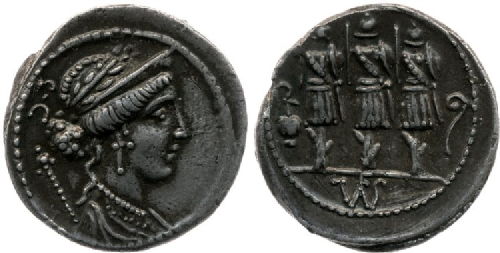 |
 |
| RRC 426/3 | RRC 426/4 |
Why did the question of who was responsible for the capture of Jugurtha matter so much not only to Marius and Sulla, but also to the next generation? Roman politics was intensely competitive, with individuals striving against each other for opportunities to serve the state. If one could demonstrate that one’s ancestors had already served the state gloriously, this was one way to gain prestige and a better chance of election. The memories and monuments of past successes mattered so much to Roman politicians because their lives were defined by the competition for glory, praise, and honours. These had to be publicly bestowed and commemorated. Politicians would remind the Roman people of their ancestor’s achievements in the hopes that they too would be allowed to serve the state and achieve glory. It was a competition for symbolic capital which consistently, though not exclusively, returned the members of the same few families to the highest magistracies.
 |
This month's entry was written by Dr. Hannah Mitchell. Hannah specialises in the political culture of the late republic and Augustan periods. She is writing a book on political careers and aristocratic self-presentation during the civil wars of the 40s and 30s BC.
Coin images reproduced courtesy of the British Museum (©The Trustees of the British Museum).
Bibliography
Flower, H. 2006. The Art of Forgetting: Disgrace and Oblivion in Roman Political Culture, Chapel Hill.
Harlan, M. 2015 (2nd edn). Roman Republican Moneyers and their Coins, 63 BC – 49 BC, London.
Mackay, C.S. 2000. ‘Sulla and the Monuments: Studies in his Public Persona’, Historia 49.2, 161-210.
June 01, 2015
Aes Grave
Compared with most of the Greek world Rome was a latecomer in its adoption of coinage; one might say indeed that it blundered its way onto the numismatic scene in a way that is really only understandable in the context of its geographical and cultural position within central Italy. The virtual absence of precious metals from the area, except what could be acquired through trade, tribute or war-booty, meant that the region’s medium of exchange had long been copper alloy. This had initially taken the form of rough pieces of metal (Aes Rude), which had to be weighed out to gauge their value. One stage on from this are cast ingots associated with Rome’s neighbours, often bearing dry-branch motifs (hence the description Ramo Secco) and usually found broken into smaller units. This idea the Romans adapted to produce their own ingots (Aes Signatum) bearing a variety of motifs (shields, sword & scabbard, cattle, elephant and pig, tripod and trident) – and of various weights: from c. 1000g. to 1850g.
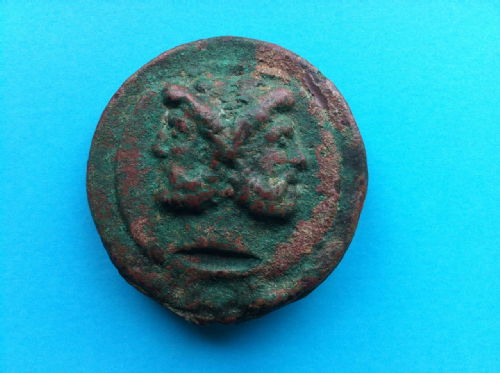 |
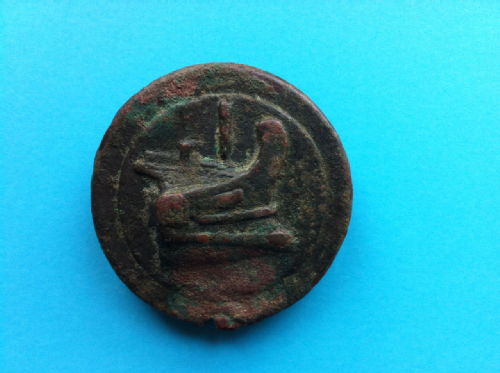 |
Aes grave coin with the head of Janus on the obverse and a prow on the reverse.
Round coinage, such as we would recognise, in the context of Rome, though, is curiously not at first the product of Rome itself but of the Greek colony of Naples to the south: silver and copper issues bearing the name of Rome but with a man-headed bull motif that is clearly a reference to Naples. Probably produced in the last decades of the fourth century, their purpose remains obscure – perhaps to record some treaty between the two states. Certainly their rarity does not suggest a significant commercial purpose. In the early decades of the third century more silver issues more evidently Roman begin to appear, though whether actually produced in Rome is a moot point since their style is clearly still Greek. Internally, however, Rome itself was still wed to the idea of bronze and, more significantly, to the idea that weight of metal and value went hand-in-hand. Hence what appeared was the weighty Aes Grave coinage, based on the As unit of account, often weighing in the region of 320g., fractioned down to a twelfth, and in the case of the very first issue (the so-called Janus-Mercury issue because of the motifs on obverse and reverse) down to a twenty-fourth. For a period of some ninety years this currency formed the staple medium of exchange, the only variation being changes of motif (e.g. the Apollo-Apollo series, the Wheel series), and around the middle of the century a lightening of the As to 280g., perhaps in order to bring base metal and silver into some kind of relationship. Rome’s apparent fixation with weight and value, however, was not to last. Around 225 BC the last Aes Grave series was issued, the so-called Prow-series, bearing the two-faced image of Janus on the obverse of the As and the prow of a galley on the reverse, as in the illustration here. Again this basic unit was fractioned, with the head of Saturn on the half, Mars on the third, Hercules on the quarter, Mercury on the sixth, and Roma on the twelfth, and with the prow reverse common to all denominations. And, if such clumsy coinage were not enough, Rome also minted a now-unique monstrous 5-As piece, doubtless on the analogy of the three- and two-As pieces of the Wheel series.
The system, though, was to suffer serious disruption when in 218 BC Hannibal invaded Italy and severed Rome from its metal supplies. In short, Rome went bankrupt and for a time waged war on credit from its citizens. The effect must have been catastrophic: to conserve metal, over a period of six years the Aes Grave suffered a series of weight reductions till in 212 it was a mere sixth of what it had been; the silver coinage being issued underwent a drop in both weight and fineness of the metal –content until it was abandoned and replaced by a new silver coinage (the denarius), and gold as an emergency currency began to appear. It cannot be underestimated to what extent the losses in manpower and resources affected the city; yet within a decade of 212 Rome was to emerge victorious over Carthage, became the dominant power in the western Mediterranean, and had produced a new currency that was to remain essentially standardised for the next two hundred years.
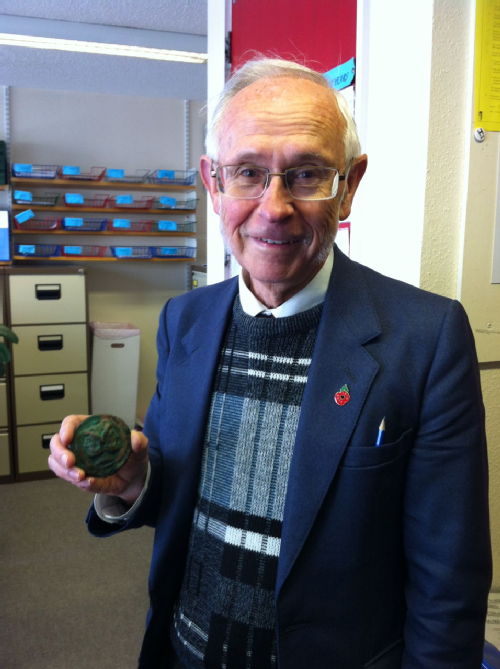
This month's coin was written by Stanley Ireland, an emeritus reader in the department.
February 13, 2015
The Social Life of Images in the Social War
In the period 90-88 BC several Italian allies revolted from Roman control, objecting that they contributed resources and troops to the Roman cause while receiving little in return. The assassination of Marcus Livius Drusus, who proposed granting Italian allies Roman citizenship, in 91 BC sparked revolt. The Italians created their own confederation named Italia, with a new capital at Corfinium, which was renamed Italica (see Diodorus Siculus 37.4).
 |
|
Roman Republican Denarius showing Apollo and Roma
(RRC 335/1). © The Trustees of the British Museum
|
The Italians also began to strike their own coinage, which carried a mixture of Roman and non-Roman elements. The coins were denarii, and circulated alongside Roman issues (at least, we find them buried alongside Roman denarii in hoards). Alongside Latin, Oscan was used. Some types derived from Roman coinage; one in particular demonstrates how imagery can shift and change meaning according to context, an idea explored in several other posts on this blog. In c. 96 BC the moneyers at Rome released a type showing the wreathed head of Apollo on the obverse and Roma seated on a pile of shields on the reverse, holding a sword and shield and being crowned by Victory (RRC 335/1-2).
This imagery was then adopted by the Italians during the Social War, but the head of Apollo and the figure of Roma were given a very different meaning. On one type (HN Italy 412a) the laureate head is given a necklace and accompanied by the legend ITALIA: the head has now become the personification of Italia herself. On the other issue (HN Italy 412b), the legend ITALIA is found on the reverse, suggesting that the image of Roma being crowned by Victory has transformed into a triumphant image of Italia.
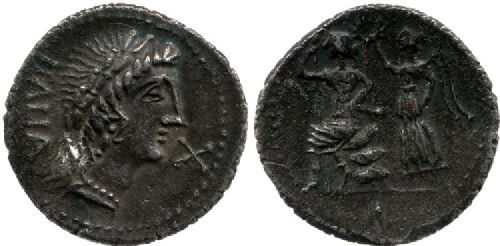 |
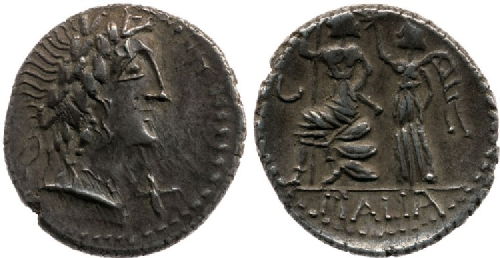 |
|
Denarius of the Italians from the Social War (HN Italy 412a). © The Trustees of the British Museum.
|
Denarius of the Italians from the Social War (HN Italy 412b). © The Trustees of the British Museum.
|
Thus during their rebellion from Roman control the Italians took existing imagery and converted it to support their cause, communciating these new meanings through the clever use and placement of legends. That the Italians felt the need to strike their own coinage demonstrates the role of money in the formulation and expression of identity. These coins and others struck by the Italians represent one of the few pieces of evidence that suggest dissatisfaction with Roman Republican control. The Romans did not take too kindly to this material manifestation of opposition: at the end of the war, it is clear that the coinage of the Italian allies was melted down and converted into Roman denarii. What is left to us today are those coins which were lost before the conclusion of the war, or those which somehow were overlooked during this process.
December 10, 2014
The eagle and the thunderbolt
Writing about web page http://www2.warwick.ac.uk/fac/cross_fac/iatl/funding/fundedprojects/fellowships/rowan/
Something a little different - in the last few weeks, as part of the Hellenistic World module, my students and I have been considering how to represent the ancient world and academic research in new (digital) ways. Here is my first attempt at a Digital story examining the ancient world, incorporating an idea that comes from my research. Enjoy!
https://www.youtube.com/watch?v=CKX0U7arQFw&feature=youtu.be
 Clare Rowan
Clare Rowan

 Please wait - comments are loading
Please wait - comments are loading


 Loading…
Loading…

